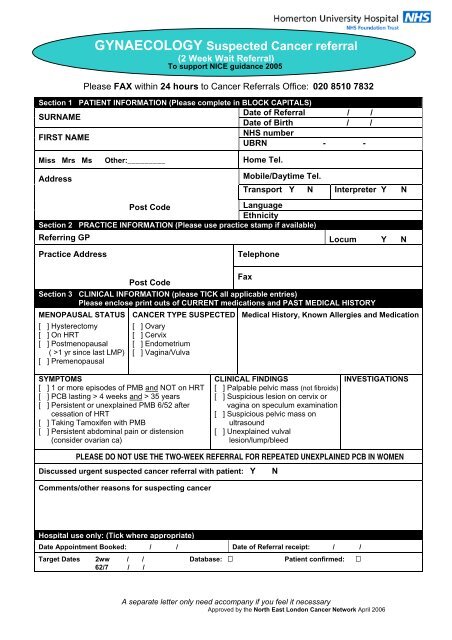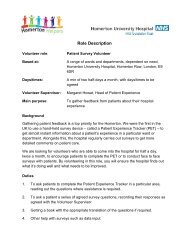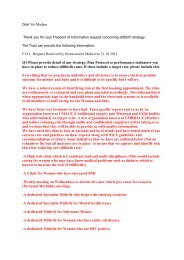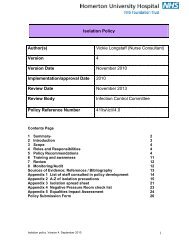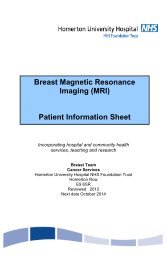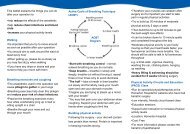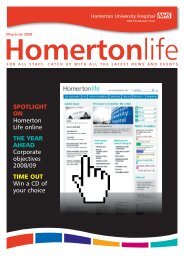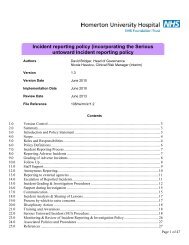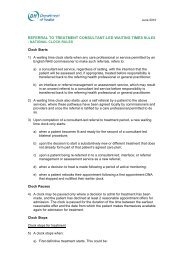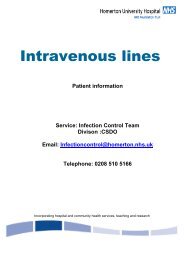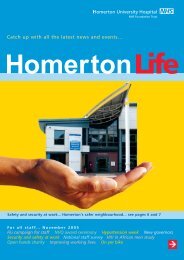Breast Suspected Cancer Referral - Homerton University Hospital
Breast Suspected Cancer Referral - Homerton University Hospital
Breast Suspected Cancer Referral - Homerton University Hospital
Create successful ePaper yourself
Turn your PDF publications into a flip-book with our unique Google optimized e-Paper software.
GYNAECOLOGY <strong>Suspected</strong> <strong>Cancer</strong> referral(2 Week Wait <strong>Referral</strong>)To support NICE guidance 2005Please FAX within 24 hours to <strong>Cancer</strong> <strong>Referral</strong>s Office: 020 8510 7832Section 1 PATIENT INFORMATION (Please complete in BLOCK CAPITALS)SURNAMEDate of <strong>Referral</strong> / /Date of Birth / /FIRST NAMENHS numberUBRN - -Miss Mrs Ms Other:_________ Home Tel.AddressMobile/Daytime Tel.Post CodeLanguageEthnicitySection 2 PRACTICE INFORMATION (Please use practice stamp if available)Transport Y N Interpreter Y NReferring GP Locum Y NPractice AddressTelephonePost CodeSection 3 CLINICAL INFORMATION (please TICK all applicable entries)Please enclose print outs of CURRENT medications and PAST MEDICAL HISTORYMENOPAUSAL STATUS[ ] Hysterectomy[ ] On HRT[ ] Postmenopausal( >1 yr since last LMP)[ ] PremenopausalCANCER TYPE SUSPECTED[ ] Ovary[ ] Cervix[ ] Endometrium[ ] Vagina/VulvaFaxMedical History, Known Allergies and MedicationSYMPTOMS[ ] 1 or more episodes of PMB and NOT on HRT[ ] PCB lasting > 4 weeks and > 35 years[ ] Persistent or unexplained PMB 6/52 aftercessation of HRT[ ] Taking Tamoxifen with PMB[ ] Persistent abdominal pain or distension(consider ovarian ca)CLINICAL FINDINGS[ ] Palpable pelvic mass (not fibroids)[ ] Suspicious lesion on cervix orvagina on speculum examination[ ] Suspicious pelvic mass onultrasound[ ] Unexplained vulvallesion/lump/bleedINVESTIGATIONSPLEASE DO NOT USE THE TWO-WEEK REFERRAL FOR REPEATED UNEXPLAINED PCB IN WOMENDiscussed urgent suspected cancer referral with patient: Y NComments/other reasons for suspecting cancer<strong>Hospital</strong> use only: (Tick where appropriate)Date Appointment Booked: / / Date of <strong>Referral</strong> receipt: / /Target Dates 2ww / / Database: Patient confirmed:62/7 / /A separate letter only need accompany if you feel it necessaryApproved by the North East London <strong>Cancer</strong> Network April 2006
LOCAL CONTACT DETAILSShould you wish to discuss this referral, please contact:Sue Carew; Gynae/Onc CNS Acute Gynae UnitTelephone 020 8510 7272Bleep 039 via switchboard (020 8510 5555)Aircall via switchboard (020 8510 5555)If you wish to discuss any other aspect of this referral please contact the <strong>Cancer</strong><strong>Referral</strong> Office on 020 8510 5099CRITERIA FOR URGENT SUSPECTED CANCER REFERRAL 1Please FAX the referral form within 24 hoursRefer a patient who presents with symptoms suggesting gynaecological cancer to ateam specialising in the management of gynaecological cancer, depending on localarrangements.Investigations• A full pelvic examination, including speculum examination of the cervix, isrecommended for patients presenting with any of the following:- alterations in the menstrual cycle- intermenstrual bleeding- postcoital bleeding- postmenopausal bleeding- vaginal discharge.• Ovarian cancer is difficult to diagnose. In patients with vague, non-specific,unexplained abdominal symptoms such as:- bloating- constipation- abdominal pain- back pain- urinary symptomscarry out an abdominal palpation. Also consider a pelvic examination.• In patients with vulval pruritus or pain, a period of ‘treat, watch and wait’ isreasonable. Active follow-up is recommended until symptoms resolve or adiagnosis is confirmed. If symptoms persist, the referral may be urgent or nonurgent,depending on the symptoms and the degree of concern about cancer.Both cervical and endometrial cancer can produce intermenstrual bleeding, althoughendometrial cancer is much more common in postmenopausal women.1 Based on <strong>Referral</strong> Guidelines for <strong>Suspected</strong> <strong>Cancer</strong> (NICE, 2005) Notes in grey refer to the evidence grading usedin the NICE guidelines, for more information see www.nice.org.uk/cg027NICEguideline


